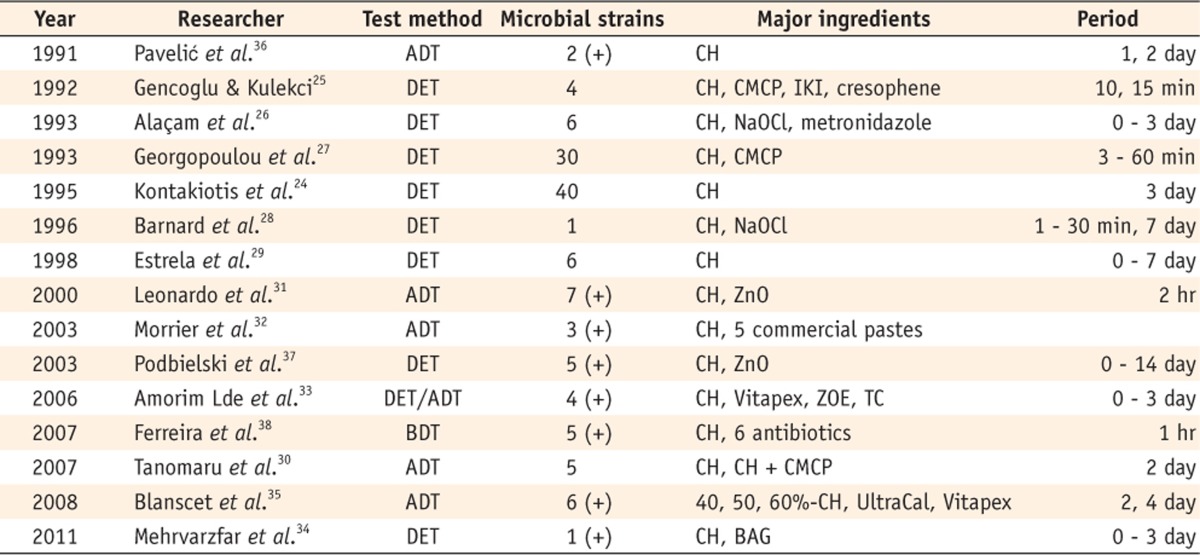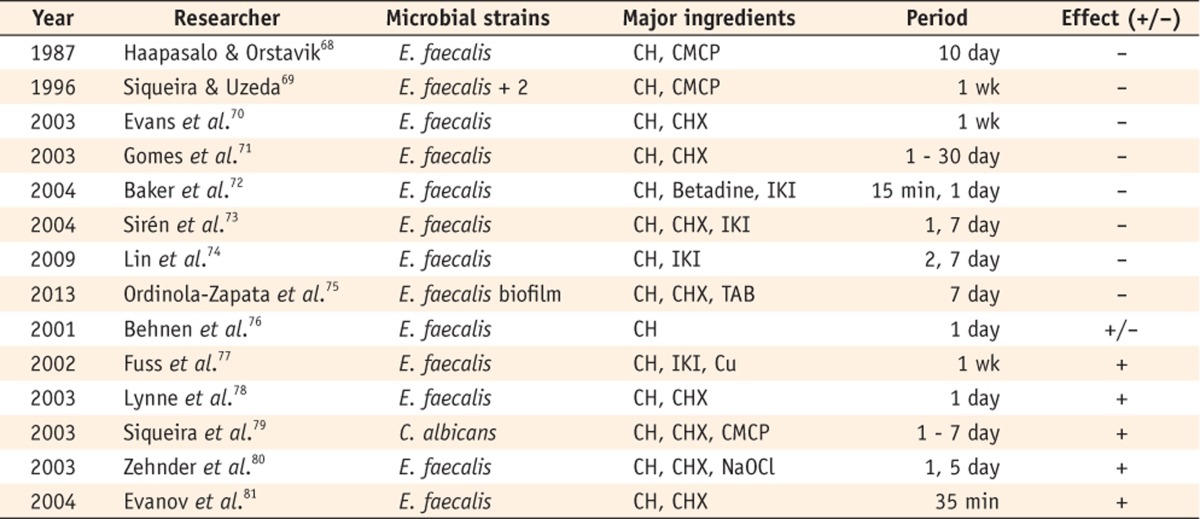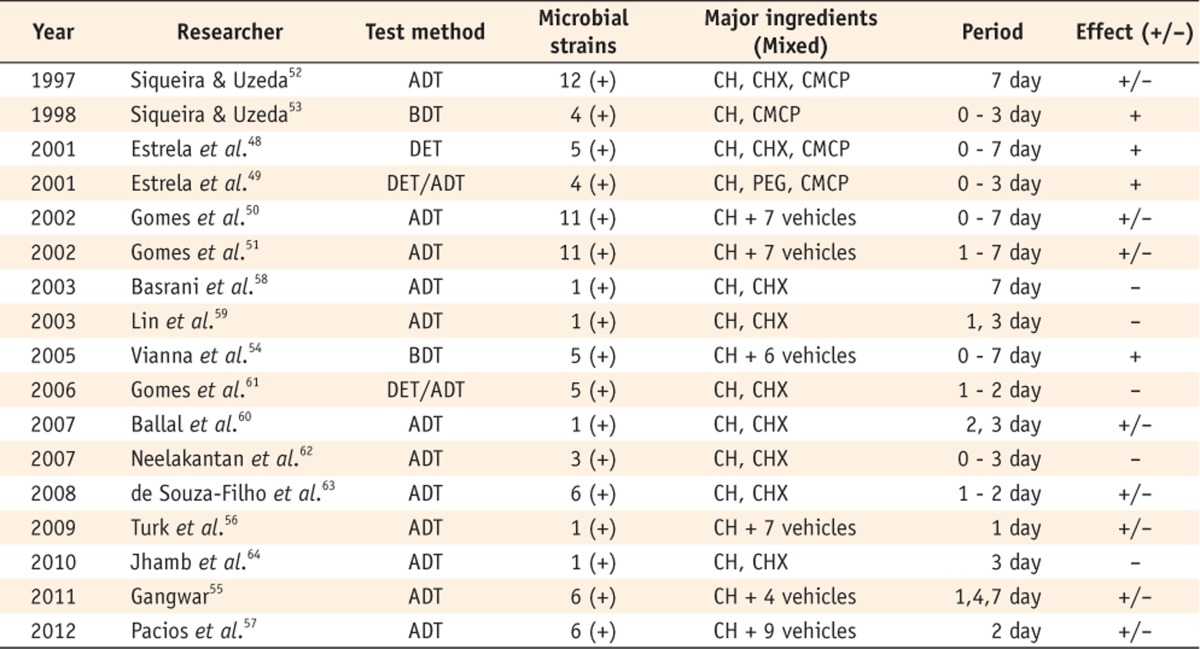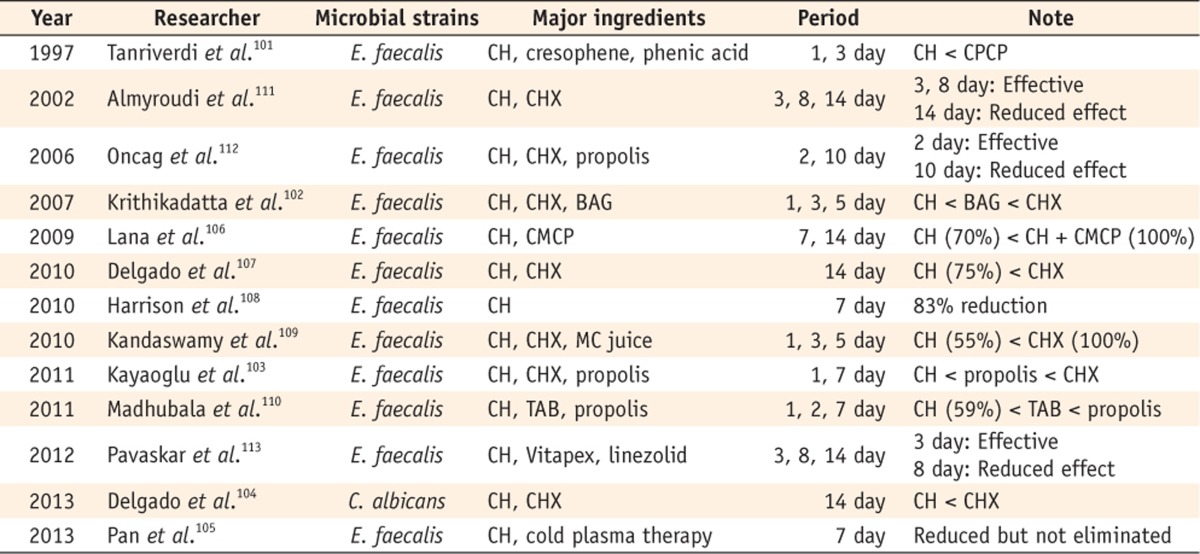1. Kakehashi S, Stanley HR, Fitzgerald RJ. The effects of surgical exposures of dental pulps in germ-free and conventional laboratory rats. Oral Surg Oral Med Oral Pathol. 1965; 20:340–349. PMID:
14342926.

2. Byström A, Sundqvist G. Bacteriologic evaluation of the effect of 0.5 percent sodium hypochlorite in endodontic therapy. Oral Surg Oral Med Oral Pathol. 1983; 55:307–312. PMID:
6572884.
3. Byström A, Claesson R, Sundqvist G. The antibacterial effect of camphorated paramonochlorophenol, camphorated phenol and calcium hydroxide in the treatment of infected root canals. Endod Dent Traumatol. 1985; 1:170–175. PMID:
3865763.
4. Byström A, Sundqvist G. The antibacterial action of sodium hypochlorite and EDTA in 60 cases of endodontic therapy. Int Endod J. 1985; 18:35–40. PMID:
3922900.

5. Sjögren U, Sundqvist G. Bacteriologic evaluation of ultrasonic root canal instrumentation. Oral Surg Oral Med Oral Pathol. 1987; 63:366–370. PMID:
3473364.

6. Shuping GB, Orstavik D, Sigurdsson A, Trope M. Reduction of intracanal bacteria using nickel-titanium rotary instrumentation and various medications. J Endod. 2000; 26:751–755. PMID:
11471648.

7. Byström A, Sundqvist G. Bacteriologic evaluation of the efficacy of mechanical root canal instrumentation in endodontic therapy. Scand J Dent Res. 1981; 89:321–328. PMID:
6947391.
8. Metzler RS, Montgomery S. Effectiveness of ultrasonics and calcium hydroxide for the debridement of human mandibular molars. J Endod. 1989; 15:373–378. PMID:
2637330.
9. Peters OA, Laib A, Göhring TN, Barbakow F. Changes in root canal geometry after preparation assessed by high-resolution computed tomography. J Endod. 2001; 27:1–6. PMID:
11487156.

10. Walton RE. Intracanal medicaments. Dent Clin North Am. 1984; 28:783–796. PMID:
6594278.
11. Hermann BW. Calcium hydroxyd als Mittelzurn, Behandeln und Fullen von Wurzelkanalen [Thesis]. Wurzburg: 1920.
12. Hasselgren G, Olsson B, Cvek M. Effects of calcium hydroxide and sodium hypochlorite on the dissolution of necrotic porcine muscle tissue. J Endod. 1988; 14:125–127. PMID:
3268627.

13. Tronstad L. Root resorption-etiology, terminology and clinical manifestations. Endod Dent Traumatol. 1988; 4:241–252. PMID:
3078294.
14. Foreman PC, Barnes IE. Review of calcium hydroxide. Int Endod J. 1990; 23:283–297. PMID:
2098345.
15. Sjogren U, Hagglund B, Sundqvist G, Wing K. Factors affecting the long-term results of endodontic treatment. J Endod. 1990; 16:498–504. PMID:
2084204.
16. De Moor RJ, De Witte AM. Periapical lesions accidentally filled with calcium hydroxide. Int Endod J. 2002; 35:946–958. PMID:
12453025.

17. Farhad A, Mohammadi Z. Calcium hydroxide: a review. Int Dent J. 2005; 55:293–301. PMID:
16245464.

18. Heithersay GS. Calcium hydroxide in the treatment of pulpless teeth with associated pathology. J Br Endod Soc. 1975; 8:74–93. PMID:
1058189.

19. Freeman BA, Crapo JD. Biology of disease: free radicals and tissue injury. Lab Invest. 1982; 47:412–426. PMID:
6290784.
20. Siqueira JF Jr, Lopes HP. Mechanisms of antimicrobial activity of calcium hydroxide: a critical review. Int Endod J. 1999; 32:361–369. PMID:
10551109.

21. Halliwell B. Oxidants and human disease: some new concepts. FASEB J. 1987; 1:358–364. PMID:
2824268.
22. Estrela C, Holland R. Calcium hydroxide: study based on scientific evidences. J Appl Oral Sci. 2003; 11:269–282. PMID:
21394401.

23. Imlay JA, Linn S. DNA damage and oxygen radical toxicity. Science. 1988; 240:1302–1309. PMID:
3287616.

24. Kontakiotis E, Nakou M, Georgopoulou M.
In vitro study of the indirect action of calcium hydroxide on the anaerobic flora of the root canal. Int Endod J. 1995; 28:285–289. PMID:
8601517.
25. Gencoglu N, Külekçi G. Antibacterial efficacy of root canal medicaments. J Nihon Univ Sch Dent. 1992; 34:233–236. PMID:
1337555.

26. Alaçam T, Omürlü H, Ozkul A, Görgül G, Misirligil A. Cytotoxicity versus antibacterial activity of some antiseptics
in vitro. J Nihon Univ Sch Dent. 1993; 35:22–27. PMID:
8100851.
27. Georgopoulou M, Kontakiotis E, Nakou M.
In vitro evaluation of the effectiveness of calcium hydroxide and paramonochlorophenol on anaerobic bacteria from the root canal. Endod Dent Traumatol. 1993; 9:249–253. PMID:
8143576.
28. Barnard D, Davies J, Figdor D. Susceptibility of Actinomyces israelii to antibiotics, sodium hypochlorite and calcium hydroxide. Int Endod J. 1996; 29:320–326. PMID:
9206415.

29. Estrela C, Pimenta FC, Ito IY, Bammann LL.
In vitro determination of direct antimicrobial effect of calcium hydroxide. J Endod. 1998; 24:15–17. PMID:
9487859.
30. Tanomaru JM, Pappen FG, Tanomaru Filho M, Spolidorio DM, Ito IY.
In vitro antimicrobial activity of different gutta-percha points and calcium hydroxide pastes. Braz Oral Res. 2007; 21:35–39. PMID:
17384853.
31. Leonardo MR, da Silva LA, Tanomaru Filho M, Bonifácio KC, Ito IY.
In vitro evaluation of antimicrobial activity of sealers and pastes used in endodontics. J Endod. 2000; 26:391–394. PMID:
11199762.
32. Morrier JJ, Benay G, Hartmann C, Barsotti O. Antimicrobial activity of Ca(OH)
2 dental cements: an
in vitro study. J Endod. 2003; 29:51–54. PMID:
12540221.
33. Amorim Lde F, Toledo OA, Estrela CR, Decurcio Dde A, Estrela C. Antimicrobial analysis of different root canal filling pastes used in pediatric dentistry by two experimental methods. Braz Dent J. 2006; 17:317–322. PMID:
17262146.
34. Mehrvarzfar P, Akhavan H, Rastgarian H, Mohammadzade Akhlagi N, Soleymanpour R, Ahmadi A. An
in vitro comparative study on the antimicrobial effects of bioglass 45S5 vs. calcium hydroxide on
Enterococcus faecalis. Iran Endod J. 2011; 6:29–33. PMID:
23130052.
35. Blanscet ML, Tordik PA, Goodell GG. An agar diffusion comparison of the antimicrobial effect of calcium hydroxide at five different concentrations with three different vehicles. J Endod. 2008; 34:1246–1248. PMID:
18793931.

36. Pavelić B, Anić I, Najzar-Fleger D, Stilinović B, Temmer K. The antimicrobial efficiency of aqueous solutions of calcium hydroxide on
Streptococcus mutans,
Streptococcus faecalis and
Candida albicans,
in vitro. Acta Stomatol Croat. 1991; 25:207–212. PMID:
1819950.
37. Podbielski A, Spahr A, Haller B. Additive antimicrobial activity of calcium hydroxide and chlorhexidine on common endodontic bacterial pathogens. J Endod. 2003; 29:340–345. PMID:
12775007.

38. Ferreira FB, Torres SA, Rosa OP, Ferreira CM, Garcia RB, Marcucci MC, Gomes BP. Antimicrobial effect of propolis and other substances against selected endodontic pathogens. Oral Surg Oral Med Oral Pathol Oral Radiol Endod. 2007; 104:709–716. PMID:
17964476.
39. Ohara P, Torabinejad M, Kettering JD. Antibacterial effects of various endodontic irrigants on selected anaerobic bacteria. Endod Dent Traumatol. 1993; 9:95–100. PMID:
8243347.

40. Barbosa SV, Spangberg LS, Almeida D. Low surface tension calcium hydroxide solution is an effective antiseptic. Int Endod J. 1994; 27:6–10. PMID:
7806414.

41. Ferreira CM, da Silva Rosa OP, Torres SA, Ferreira FB, Bernardinelli N. Activity of endodontic antibacterial agents against selected anaerobic bacteria. Braz Dent J. 2002; 13:118–122. PMID:
12238802.

42. Rosa OP, Torres SA, Ferreira CM, Ferreira FB.
In vitro effect of intracanal medicaments on strict anaerobes by means of the broth dilution method. Pesqui Odontol Bras. 2002; 16:31–36. PMID:
11938715.
43. Reddy S, Ramakrishna Y. Evaluation of antimicrobial efficacy of various root canal filling materials used in primary teeth: a microbiological study. J Clin Pediatr Dent. 2007; 31:193–198. PMID:
17550046.

44. Badr AE, Omar N, Badria FA. A laboratory evaluation of the antibacterial and cytotoxic effect of Liquorice when used as root canal medicament. Int Endod J. 2011; 44:51–58. PMID:
20812941.

45. Hegde S, Lala PK, Dinesh RB, Shubha AB. An
in vitro evaluation of antimicrobial efficacy of primary root canal filling materials. J Clin Pediatr Dent. 2012; 37:59–64. PMID:
23342568.
46. Mattigatti S, Ratnakar P, Moturi S, Varma S, Rairam S. Antimicrobial effect of conventional root canal medicaments vs propolis against
Enterococcus faecalis,
Staphylococcus aureus and
Candida albicans. J Contemp Dent Pract. 2012; 13:305–309. PMID:
22918001.
47. Adl A, Shojaee NS, Motamedifar M. A comparison between the antimicrobial effects of triple antibiotic paste and calcium hydroxide against
Entrococcus Faecalis. Iran Endod J. 2012; 7:149–155. PMID:
23056135.
48. Estrela C, Bammann LL, Pimenta FC, Pécora JD. Control of microorganisms
in vitro by calcium hydroxide pastes. Int Endod J. 2001; 34:341–345. PMID:
11482716.
49. Estrela C, Rodrigues de Araújo Estrela C, Bammann LL, Pecora JD. Two methods to evaluate the antimicrobial action of calcium hydroxide paste. J Endod. 2001; 27:720–723. PMID:
11771575.

50. Gomes BP, Ferraz CC, Garrido FD, Rosalen PL, Zaia AA, Teixeira FB, de Souza-Filho FJ. Microbial susceptibility to calcium hydroxide pastes and their vehicles. J Endod. 2002; 28:758–761. PMID:
12470019.
51. Gomes BP, Ferraz CC, Vianna ME, Rosalen PL, Zaia AA, Teixeira FB, Souza-Filho FJ.
In vitro antimicrobial activity of calcium hydroxide pastes and their vehicles against selected microorganisms. Braz Dent J. 2002; 13:155–161. PMID:
12428587.
52. Siqueira JF Jr, de Uzeda M. Intracanal medicaments: evaluation of the antibacterial effects of chlorhexidine, metronidazole, and calcium hydroxide associated with three vehicles. J Endod. 1997; 23:167–169. PMID:
9594757.

53. Siqueira JF Jr, de Uzeda M. Influence of different vehicles on the antibacterial effects of calcium hydroxide. J Endod. 1998; 24:663–665. PMID:
10023249.

54. Vianna ME, Gomes BP, Sena NT, Zaia AA, Ferraz CC, de Souza Filho FJ.
In vitro evaluation of the susceptibility of endodontic pathogens to calcium hydroxide combined with different vehicles. Braz Dent J. 2005; 16:175–180. PMID:
16429180.
55. Gangwar A. Antimicrobial effectiveness of different preparations of calcium hydroxide. Indian J Dent Res. 2011; 22:66–70. PMID:
21525680.

56. Turk BT, Sen BH, Ozturk T.
In vitro antimicrobial activity of calcium hydroxide mixed with different vehicles against
Enterococcus faecalis and
Candida albicans. Oral Surg Oral Med Oral Pathol Oral Radiol Endod. 2009; 108:297–301. PMID:
19615665.
57. Pacios MG, Silva C, López ME, Cecilia M. Antibacterial action of calcium hydroxide vehicles and calcium hydroxide pastes. J Investig Clin Dent. 2012; 3:264–270.

58. Basrani B, Tjaderhane L, Santos JM, Pascon E, Grad H, Lawrence HP, Friedman S. Efficacy of chlorhexidine- and calcium hydroxide-containing medicaments against
Enterococcus faecalis in vitro. Oral Surg Oral Med Oral Pathol Oral Radiol Endod. 2003; 96:618–624. PMID:
14600699.
59. Lin YH, Mickel AK, Chogle S. Effectiveness of selected materials against Enterococcus faecalis: part 3. The antibacterial effect of calcium hydroxide and chlorhexidine on Enterococcus faecalis. J Endod. 2003; 29:565–566. PMID:
14503828.

60. Ballal V, Kundabala M, Acharya S, Ballal M. Antimicrobial action of calcium hydroxide, chlorhexidine and their combination on endodontic pathogens. Aust Dent J. 2007; 52:118–121. PMID:
17687957.

61. Gomes BP, Vianna ME, Sena NT, Zaia AA, Ferraz CC, de Souza Filho FJ.
In vitro evaluation of the antimicrobial activity of calcium hydroxide combined with chlorhexidine gel used as intracanal medicament. Oral Surg Oral Med Oral Pathol Oral Radiol Endod. 2006; 102:544–550. PMID:
16997123.
62. Neelakantan P, Sanjeev K, Subbarao CV. Duration-dependent susceptibility of endodontic pathogens to calcium hydroxide and chlorhexidene gel used as intracanal medicament: an
in vitro evaluation. Oral Surg Oral Med Oral Pathol Oral Radiol Endod. 2007; 104:e138–e141. PMID:
17689115.
63. de Souza-Filho FJ, Soares Ade J, Vianna ME, Zaia AA, Ferraz CC, Gomes BP. Antimicrobial effect and pH of chlorhexidine gel and calcium hydroxide alone and associated with other materials. Braz Dent J. 2008; 19:28–33. PMID:
18438556.
64. Jhamb S, Nikhil V, Singh V. An
in vitro study of antibacterial effect of calcium hydroxide and chlorhexidine on
Enterococcus faecalis. Indian J Dent Res. 2010; 21:512–514. PMID:
21187615.
65. Portenier I, Waltimo T, Ørstavik D, Haapasalo M. The susceptibility of starved, stationary phase, and growing cells of
Enterococcus faecalis to endodontic medicaments. J Endod. 2005; 31:380–386. PMID:
15851934.
66. Oliveira JC, Alves FR, Uzeda M, Rôças IN, Siqueira JF Jr. Influence of serum and necrotic soft tissue on the antimicrobial effects of intracanal medicaments. Braz Dent J. 2010; 21:295–300. PMID:
20976377.

67. Ribeiro DA. Do endodontic compounds induce genetic damage? A comprehensive review. Oral Surg Oral Med Oral Pathol Oral Radiol Endod. 2008; 105:251–256. PMID:
18230394.

68. Haapasalo M, Orstavik D.
In vitro infection and disinfection of dentinal tubules. J Dent Res. 1987; 66:1375–1379. PMID:
3114347.
69. Siqueira JF Jr, de Uzeda M. Disinfection by calcium hydroxide pastes of dentinal tubules infected with two obligate and one facultative anaerobic bacteria. J Endod. 1996; 22:674–676. PMID:
9220753.

70. Evans MD, Baumgartner JC, Khemaleelakul SU, Xia T. Efficacy of calcium hydroxide: chlorhexidine paste as an intracanal medication in bovine dentin. J Endod. 2003; 29:338–339. PMID:
12775006.

71. Gomes BP, Souza SF, Ferraz CC, Teixeira FB, Zaia AA, Valdrighi L, Souza-Filho FJ. Effectiveness of 2% chlorhexidine gel and calcium hydroxide against
Enterococcus faecalis in bovine root dentine
in vitro. Int Endod J. 2003; 36:267–275. PMID:
12702121.
72. Baker NE, Liewehr FR, Buxton TB, Joyce AP. Antibacterial efficacy of calcium hydroxide, iodine potassium iodide, betadine, and betadine scrub with and without surfactant against
E faecalis in vitro. Oral Surg Oral Med Oral Pathol Oral Radiol Endod. 2004; 98:359–364. PMID:
15356477.
73. Sirén EK, Haapasalo MP, Waltimo TM, Ørstavik D. In vitro antibacterial effect of calcium hydroxide combined with chlorhexidine or iodine potassium iodide on
Enterococcus faecalis. Eur J Oral Sci. 2004; 112:326–331. PMID:
15279651.
74. Lin S, Kfir A, Laviv A, Sela G, Fuss Z. The
in vitro antibacterial effect of iodine-potassium iodide and calcium hydroxide in infected dentinal tubules at different time intervals. J Contemp Dent Pract. 2009; 10:59–66. PMID:
19279973.
75. Ordinola-Zapata R, Bramante CM, Minotti PG, Cavenago BC, Garcia RB, Bernardineli N, Jaramillo DE, Hungaro Duarte MA. Antimicrobial activity of triantibiotic paste, 2% chlorhexidine gel, and calcium hydroxide on an intraoral-infected dentin biofilm model. J Endod. 2013; 39:115–118. PMID:
23228269.

76. Behnen MJ, West LA, Liewehr FR, Buxton TB, McPherson JC 3rd. Antimicrobial activity of several calcium hydroxide preparations in root canal dentin. J Endod. 2001; 27:765–767. PMID:
11771586.

77. Fuss Z, Mizrahi A, Lin S, Cherniak O, Weiss EI. A laboratory study of the effect of calcium hydroxide mixed with iodine or electrophoretically activated copper on bacterial viability in dentinal tubules. Int Endod J. 2002; 35:522–526. PMID:
12190909.

78. Lynne RE, Liewehr FR, West LA, Patton WR, Buxton TB, McPherson JC.
In vitro antimicrobial activity of various medication preparations on
E. faecalis in root canal dentin. J Endod. 2003; 29:187–190. PMID:
12669878.
79. Siqueira JF Jr, Rôças IN, Lopes HP, Magalhães FA, de Uzeda M. Elimination of Candida albicans infection of the radicular dentin by intracanal medications. J Endod. 2003; 29:501–504. PMID:
12929695.
80. Zehnder M, Grawehr M, Hasselgren G, Waltimo T. Tissue-dissolution capacity and dentin-disinfecting potential of calcium hydroxide mixed with irrigating solutions. Oral Surg Oral Med Oral Pathol Oral Radiol Endod. 2003; 96:608–613. PMID:
14600697.

81. Evanov C, Liewehr F, Buxton TB, Joyce AP. Antibacterial efficacy of calcium hydroxide and chlorhexidine gluconate irrigants at 37 degrees C and 46 degrees C. J Endod. 2004; 30:653–657. PMID:
15329571.
82. Nerwich A, Figdor D, Messer HH. pH changes in root dentin over a 4-week period following root canal dressing with calcium hydroxide. J Endod. 1993; 19:302–306. PMID:
8228751.

83. Safavi KE, Spangberg LS, Langeland K. Root canal dentinal tubule disinfection. J Endod. 1990; 16:207–210. PMID:
2074411.

84. Estrela C, Pimenta FC, Ito IY, Bammann LL. Antimicrobial evaluation of calcium hydroxide in infected dentinal tubules. J Endod. 1999; 25:416–418. PMID:
10530241.

85. Basson NJ, Tait CM. Effectiveness of three root canal medicaments to eliminate Actinomyces israelii from infected dentinal tubules
in vitro. SADJ. 2001; 56:499–501. PMID:
11885423.
86. Valera MC, de Moraes Rego J, Jorge AO. Effect of sodium hypochlorite and five intracanal medications on Candida albicans in root canals. J Endod. 2001; 27:401–403. PMID:
11487135.

87. Schäfer E, Bössmann K. Antimicrobial efficacy of chlorhexidine and two calcium hydroxide formulations against
Enterococcus faecalis. J Endod. 2005; 31:53–56. PMID:
15614008.
88. Ercan E, Dalli M, Dülgergil CT.
In vitro assessment of the effectiveness of chlorhexidine gel and calcium hydroxide paste with chlorhexidine against
Enterococcus faecalis and
Candida albicans. Oral Surg Oral Med Oral Pathol Oral Radiol Endod. 2006; 102:e27–e31. PMID:
16876041.
89. Gomes BP, Montagner F, Berber VB, Zaia AA, Ferraz CC, de Almeida JF, Souza-Filho FJ. Antimicrobial action of intracanal medicaments on the external root surface. J Dent. 2009; 37:76–81. PMID:
18995944.

90. Lee JK, Park YJ, Kum KY, Han SH, Chang SW, Kaufman B, Jiang J, Zhu Q, Safavi K, Spångberg L. Antimicrobial efficacy of a human β-defensin-3 peptide using an
Enterococcus faecalis dentine infection model. Int Endod J. 2013; 46:406–412. PMID:
23078156.
91. Stuart KG, Miller CH, Brown CE Jr, Newton CW. The comparative antimicrobial effect of calcium hydroxide. Oral Surg Oral Med Oral Pathol. 1991; 72:101–104. PMID:
1891227.

92. Han GY, Park SH, Yoon TC. Antimicrobial activity of Ca(OH)
2 containing pastes with
Enterococcus faecalis in vitro. J Endod. 2001; 27:328–332. PMID:
11485250.
93. Barthel CR, Zimmer S, Zilliges S, Schiller R, Göbel UB, Roulet JF.
In situ antimicrobial effectiveness of chlorhexidine and calcium hydroxide: gel and paste versus gutta-percha points. J Endod. 2002; 28:427–430. PMID:
12067121.
94. Menezes MM, Valera MC, Jorge AO, Koga-Ito CY, Camargo CH, Mancini MN.
In vitro evaluation of the effectiveness of irrigants and intracanal medicaments on microorganisms within root canals. Int Endod J. 2004; 37:311–319. PMID:
15086752.
95. Zehnder M, Luder HU, Schätzle M, Kerosuo E, Waltimo T. A comparative study on the disinfection potentials of bioactive glass S53P4 and calcium hydroxide in contralateral human premolars
ex vivo. Int Endod J. 2006; 39:952–958. PMID:
17107540.
96. Atila-Pektaş B, Yurdakul P, Gülmez D, Görduysus O. Antimicrobial effects of root canal medicaments against
Enterococcus faecalis and
Streptococcus mutans. Int Endod J. 2013; 46:413–418. PMID:
23095092.
97. Maekawa LE, Valera MC, Oliveira LD, Carvalho CA, Camargo CH, Jorge AO. Effect of Zingiber officinale and propolis on microorganisms and endotoxins in root canals. J Appl Oral Sci. 2013; 21:25–31. PMID:
23559108.

98. Valera MC, Maekawa LE, Chung A, de Oliveira LD, Carvalho CA, Koga-Ito CY, Jorge AO. Effectiveness of castor oil extract on
Escherichia coli and its endotoxins in root canals. Gen Dent. 2012; 60:e204–e209. PMID:
22782052.
99. Noetzel J, Nonhoff J, Bitter K, Wagner J, Neumann K, Kielbassa AM. Efficacy of calcium hydroxide, Er:YAG laser or gaseous ozone against Enterococcus faecalis in root canals. Am J Dent. 2009; 22:14–18. PMID:
19281107.
100. Valera MC, Silva KC, Maekawa LE, Carvalho CA, Koga-Ito CY, Camargo CH, Lima RS. Antimicrobial activity of sodium hypochlorite associated with intracanal medication for
Candida albicans and
Enterococcus faecalis inoculated in root canals. J Appl Oral Sci. 2009; 17:555–559. PMID:
20027425.
101. Tanriverdi F, Esener T, Erganiş O, Belli S. An
in vitro test model for investigation of disinfection of dentinal tubules infected with
Enterococcus faecalis. Braz Dent J. 1997; 8:67–72. PMID:
9590928.
102. Krithikadatta J, Indira R, Dorothykalyani AL. Disinfection of dentinal tubules with 2% chlorhexidine, 2% metronidazole, bioactive glass when compared with calcium hydroxide as intracanal medicaments. J Endod. 2007; 33:1473–1476. PMID:
18037062.

103. Kayaoglu G, Ömürlü H, Akca G, Gürel M, Gençay Ö, Sorkun K, Salih B. Antibacterial activity of Propolis versus conventional endodontic disinfectants against Enterococcus faecalis in infected dentinal tubules. J Endod. 2011; 37:376–381. PMID:
21329825.

104. Delgado RJ, Gasparoto TH, Sipert CR, Pinheiro CR, de Moraes IG, Garcia RB, Duarte MA, Bramante CM, Torres SA, Garlet GP, Campanelli AP, Bernardineli N. Antimicrobial activity of calcium hydroxide and chlorhexidine on intratubular
Candida albicans. Int J Oral Sci. 2013; 5:32–36. PMID:
23538639.
105. Pan J, Sun K, Liang Y, Sun P, Yang X, Wang J, Zhang J, Zhu W, Fang J, Becker KH. Cold plasma therapy of a tooth root canal infected with
Enterococcus faecalis biofilms
in vitro. J Endod. 2013; 39:105–110. PMID:
23228267.
106. Lana PE, Scelza MF, Silva LE, Mattos-Guaraldi AL, Hirata Júnior R. Antimicrobial activity of calcium hydroxide pastes on
Enterococcus faecalis cultivated in root canal systems. Braz Dent J. 2009; 20:32–36. PMID:
19466228.
107. Delgado RJ, Gasparoto TH, Sipert CR, Pinheiro CR, Moraes IG, Garcia RB, Bramante CM, Campanelli AP, Bernardineli N. Antimicrobial effects of calcium hydroxide and chlorhexidine on
Enterococcus faecalis. J Endod. 2010; 36:1389–1393. PMID:
20647103.
108. Harrison AJ, Chivatxaranukul P, Parashos P, Messer HH. The effect of ultrasonically activated irrigation on reduction of
Enterococcus faecalis in experimentally infected root canals. Int Endod J. 2010; 43:968–977. PMID:
20726913.
109. Kandaswamy D, Venkateshbabu N, Gogulnath D, Kindo AJ. Dentinal tubule disinfection with 2% chlorhexidine gel, propolis, morinda citrifolia juice, 2% povidone iodine, and calcium hydroxide. Int Endod J. 2010; 43:419–423. PMID:
20518935.

110. Madhubala MM, Srinivasan N, Ahamed S. Comparative evaluation of propolis and triantibiotic mixture as an intracanal medicament against
Enterococcus faecalis. J Endod. 2011; 37:1287–1289. PMID:
21846550.
111. Almyroudi A, Mackenzie D, McHugh S, Saunders WP. The effectiveness of various disinfectants used as endodontic intracanal medications: an
in vitro study. J Endod. 2002; 28:163–167. PMID:
12017172.
112. Oncag O, Cogulu D, Uzel A, Sorkun K. Efficacy of propolis as an intracanal medicament against
Enterococcus faecalis. Gen Dent. 2006; 54:319–322. PMID:
17004565.
113. Pavaskar R, de Ataide Ide N, Chalakkal P, Pinto MJ, Fernandes KS, Keny RV, Kamath A. An
in vitro study comparing the intracanal effectiveness of calcium hydroxide- and linezolid-based medicaments against
Enterococcus faecalis. J Endod. 2012; 38:95–100. PMID:
22152629.
114. Sukawat C, Srisuwan T. A comparison of the antimicrobial efficacy of three calcium hydroxide formulations on human dentin infected with
Enterococcus faecalis. J Endod. 2002; 28:102–104. PMID:
11833679.
115. Cwikla SJ, Bélanger M, Giguère S, Progulske-Fox A, Vertucci FJ. Dentinal tubule disinfection using three calcium hydroxide formulations. J Endod. 2005; 31:50–52. PMID:
15614007.

116. Lima RK, Guerreiro-Tanomaru JM, Faria-Júnior NB, Tanomaru-Filho M. Effectiveness of calcium hydroxide-based intracanal medicaments against
Enterococcus faecalis. Int Endod J. 2012; 45:311–316. PMID:
22077915.
117. Prabhakar AR, Hadakar SG, Raju OS. Comparative evaluation of pH and antibacterial effect of various calcium hydroxide combinations on
E. faecalis and its effect on root strength: an
in vitro study. Contemp Clin Dent. 2012; 3:42–47. PMID:
22557896.
118. Cook J, Nandakumar R, Fouad AF. Molecular- and culture-based comparison of the effects of antimicrobial agents on bacterial survival in infected dentinal tubules. J Endod. 2007; 33:690–692. PMID:
17509407.









 PDF
PDF ePub
ePub Citation
Citation Print
Print







 XML Download
XML Download